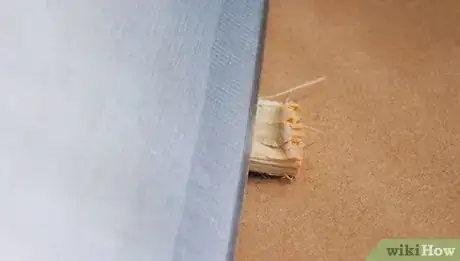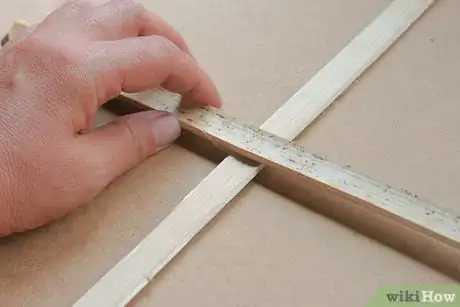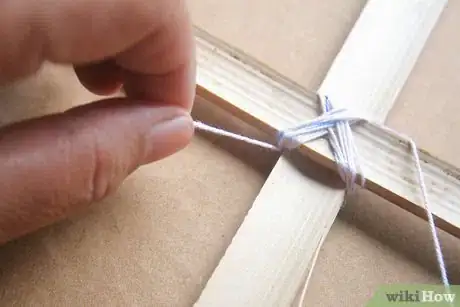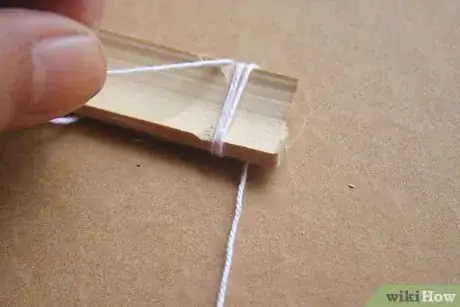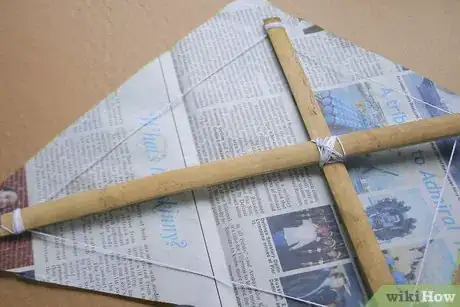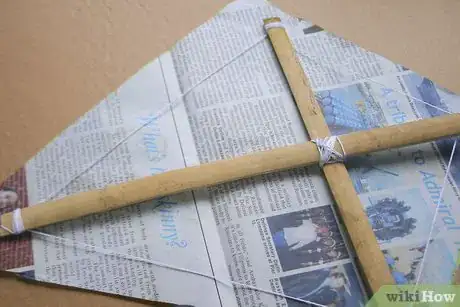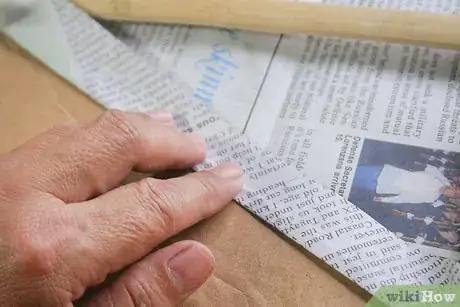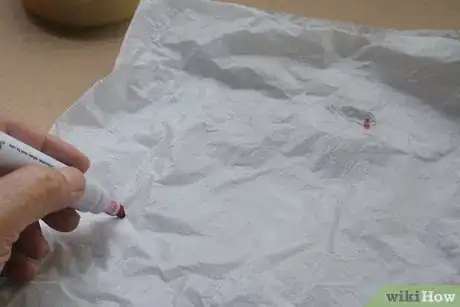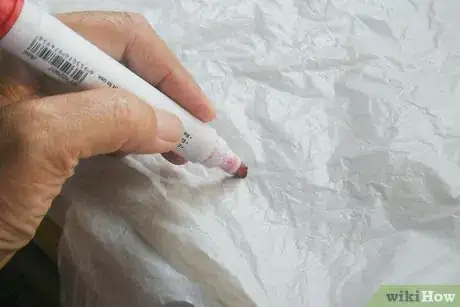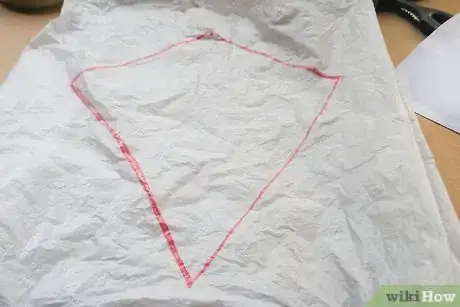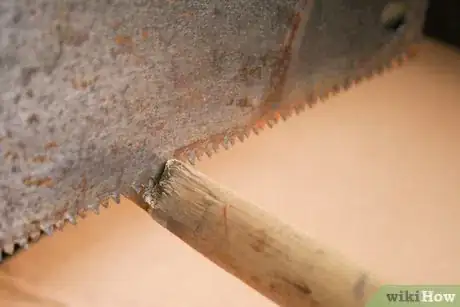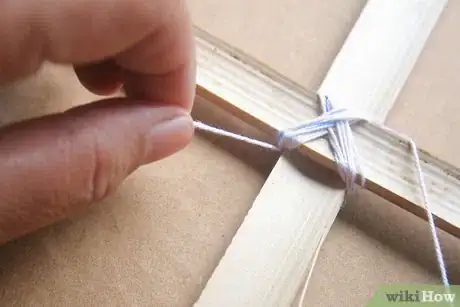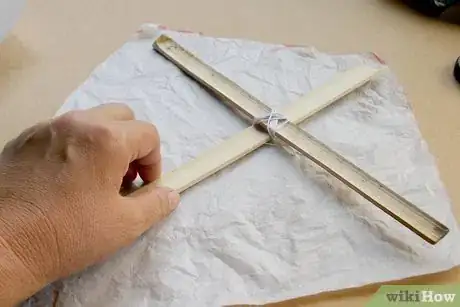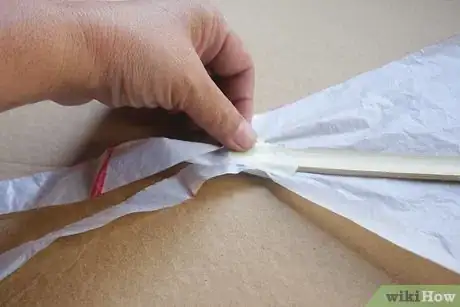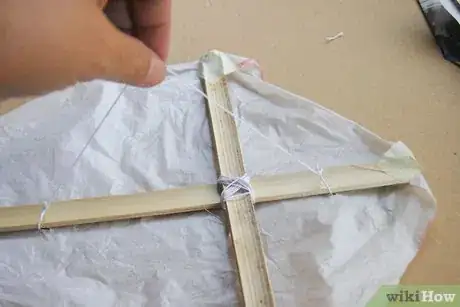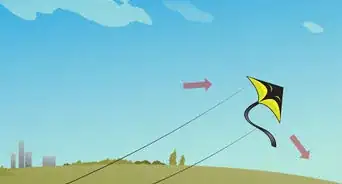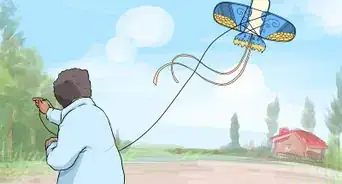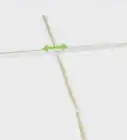X
This article was co-authored by wikiHow Staff. Our trained team of editors and researchers validate articles for accuracy and comprehensiveness. wikiHow's Content Management Team carefully monitors the work from our editorial staff to ensure that each article is backed by trusted research and meets our high quality standards.
This article has been viewed 364,716 times.
Learn more...
Diamond kites are the most basic version of traditional kites, and they are easier to make than you might think. Once you gather your materials, you can make a version which uses a string-supported frame and a paper body. You can also make a kite with a trash bag body, which may be a little sturdier than paper.
Steps
Method 1
Method 1 of 4:
Making a String Frame
-
1Cut two wooden dowels to the desired length. You can use one piece of dowel and cut it in two, or you can use two separate pieces and cut them each to length. You can use a small hacksaw, or a box cutter will work, as well. Try to get the ends as smooth as possible.[1]
- Do this outside or over a trashcan to reduce the mess.
- This length will be determined by the size of kite you want to make. The dowels can be the same length or one can be shorter. For example, both could be 40 inches, or one could be 32” and the other 24”. It’s up to you the exact shape you want for your kite.
-
2Notch the ends of the dowels. Using the saw or knife, cut notches into the ends, in which a piece of kite string will sit. The notches don’t need to be very deep, just enough that the string will fit in. Make sure the notches on each end of each dowel are going the same direction.[2]Advertisement
-
3Form a cross with the dowels. If you used two lengths, the longer one will be vertical and the shorter one will be horizontal. Place the horizontal dowel ⅓ of the way from the top of the vertical dowel.
- Make sure the vertical dowel’s notches are pointing sideways toward the horizontal dowel, and the horizontal dowel’s notches are pointing vertically toward the vertical dowel.
-
4Tie the dowels together. You’ll need about 12 inches (30 cm) of kite string. Circle the string around each angle formed by the crossed dowels. As you tie the string, make sure the dowels stay at 90 degree angles.
- Knot the string around the cross section multiple times so the dowels are held tight.
-
5Wrap string around the bottom of the vertical dowel. Starting at the bottom of the vertical dowel, wrap the kite string around five or six times. Make sure that when you finish wrapping, the string is near the end of the dowel again.
- The purpose of this is to anchor the string to the frame securely before you wrap it around the frame.
-
6Wrap the string around the frame through the notches. Starting with the bottom where you wrapped the string already, stretch the string from one notch to the next, making sure it stays tight.[3]
- Finish by hooking the string through the bottom notch and tying it off.
- The purpose of wrapping string around the frame is to help it maintain its shape when you fly the kite. It also gives you a guide for cutting the body out.
Advertisement
Method 2
Method 2 of 4:
Creating the Kite Shape for a String Frame
-
1Trace around the frame on a large sheet of paper. Newspaper usually works well for this, if it is big enough. If you can’t find a newspaper large enough, any large craft paper will work. As you draw around the string frame, leave about 1 inch (2.5 cm) extra around it.
- You don’t need to be too careful about making perfectly straight lines because what you trace will be folded later.
-
2Cut out the kite shape. Set the frame to the side and cut the kite shape out. You can discard the extra paper, as you won’t need it anymore. Be careful to stay right on the line, or even outside it a little bit, so you don’t cut the kite too small.
- Once you have finished cutting it out, lay it flat on the table and lay the frame on top of it.
-
3Fold the edges of the paper over the string and tape it in place. Make sure the frame is centered on the kite body. Going around the kite one side at a time, fold the paper over the string. Tape the corners first and then put some tape around each folded edge.
- For extra support, you can put a few pieces of tape along the dowels to secure them in place.
-
4Tie a string around the cross section. Now that the kite is fully constructed, tie a string to it, which you will hold when you fly the kite. You’ll want it to be around 20 yards (18 meters) or so. Make sure it’s long enough that the kite can fly freely.
Advertisement
Method 3
Method 3 of 4:
Making a Kite Shape with a Trash Bag
-
1Make a mark for the top point of the kite. Lay a large trash bag flat on the table. Bags meant for outdoor use are ideal because they are made of thicker material. Use a soft tip marker to make the first mark a few inches below the top, along the left edge of the bag. The edge of the bag will become the center of the kite.
- The trash bag you use needs to be at least 40 inches (100 cm) long for this kite.
- Depending on the color of the trash bag, make sure the marker you use is visible. For example, with a black trash bag a silver marker would work best.
-
2Measure a point for the side corners of the kite. Using a yardstick or tape measure, measure 10 inches (25 cm) down the edge of the bag. Then measure 20 inches (50 cm) across, which should be somewhere in the middle of the bag. Make a mark here for the side corners.[4]
-
3Measure and mark the bottom point. From the top point, measure 40 inches (100 cm) down on the edge of the bag and make a mark. The three points should now form a triangle on the bag, with the side corner mark being closer to the top mark.
- If you only have trash bags that are smaller than the given measurements, just make sure your points are proportional. The mark for the side corner should measure half of the total length, so that when the bag is unfolded the length and width are the same.
- For example, the horizontal span could be measured at 10 inches (25 cm) and the length could be 20 inches (50 cm). As long as the proportions match, a smaller kite is fine.
-
4Connect the dots with a marker. Using the yardstick or another straight edge as a guide, connect the top point to the side corner point and the side corner point to the bottom point. Your line doesn’t have to be perfectly straight, but as close as possible.
-
5Cut the shape out. Use sharp scissors or a box knife and cut as straight as you can along the lines. If you are going to use a box knife, you’ll want to put a large piece of cardboard under the material before you cut it out.
- Save the extra material after you cut the kite shape out. This will be used later.
- After you cut the kite out, unfold the diamond shape and lay it flat on the table.
Advertisement
Method 4
Method 4 of 4:
Building a Frame for a Trash Bag Kite
-
1Cut wooden dowels or bamboo sticks to 40 inches (100 cm). The dowels will be used as the frame of the kite. If you can purchase them already cut to size, that’s great, but if not, you’ll need to carefully cut them down.
- Use ¼ inch (.6 cm) dowels.
- Use either a small hacksaw or a box cutter to trim the dowels to size. Do this either outside or over the trashcan to avoid leaving sawdust all over.
- If you made the body of the kite smaller than 40 inches in length, cut the dowels to the length you measured the body at.
-
2Form a cross with the sticks and tie them at the intersection. The horizontal stick should be about 10 in (25 cm) from the top of the vertical stick. Using kite string, about 12 in (30 cm) or so, tie it tightly around the intersection of the sticks. Make a few knots so the sticks are tightly secured together.[5]
- It doesn’t matter too much how you tie the string here, as long as the sticks are secured together. You can also put some tape or glue over the string for added strength.
-
3Attach the frame to the plastic body of the kite. Make a small cut on each of the corners of the kite. Fold these flaps over the dowel pieces and tape them securely in place. Duct tape is best, but just make sure the tape holds the frame to the body securely.
- Once the corners are attached, you can place 2-4 pieces of tape along each dowel so the kite is secured across the whole body of the kite.
-
4Tie a 2 foot long strip of the plastic to the bottom of the kite. This is the tail of the kite, which will help stabilize it in the wind. You can also tie shorter strips onto the main tail for extra drag. To add more color, you could use bright strips of cloth instead.
-
5Attach the remaining kite string to the frame of the kite. Poke 4 small holes through the plastic around the center of the crossed dowels, one hole in each angle of the cross. Lead the kite string through all four holes and tie securely to the center cross section.
- This is the string which you will hold when you fly the kite, so make sure it is plenty long enough. How high a kite can fly will depend on the wind, but you’ll probably want at least 20 yards (18 meters) of string.
Advertisement
Community Q&A
-
QuestionHow long will it take to make a diamond kite?
 Community AnswerIt depends on how fast you work, but it should take around 20-30 minutes.
Community AnswerIt depends on how fast you work, but it should take around 20-30 minutes. -
QuestionCan I use bamboo sticks?
 Community AnswerYes, they will work great for your kite.
Community AnswerYes, they will work great for your kite. -
QuestionIs there any other thing to use instead of wooden dowel?
 Community AnswerYou could use shish kabob sticks if they are long enough. If you have some kind of plastic rod, that would work as well. In a pinch, you could even use sticks you find outside if they are straight and thin.
Community AnswerYou could use shish kabob sticks if they are long enough. If you have some kind of plastic rod, that would work as well. In a pinch, you could even use sticks you find outside if they are straight and thin.
Advertisement
Things You'll Need
- Wooden dowel rods (approximately 80 inches, or 2 meters, ¼ inch thick)
- Small hacksaw or knife that cuts through wood or box cutter (razor knife)
- Kite string, or other lightweight string
- Newspaper, or other large craft paper
- Soft tip marker
- Yard stick and measuring tape
- Scissors
- Tape
- Large trash bag
References
- ↑ http://www.stormthecastle.com/how-to-make-a/kite/make-a-traditional-kite.ht
- ↑ http://www.stormthecastle.com/how-to-make-a/kite/make-a-traditional-kite.htm
- ↑ http://www.dreamalittlebigger.com/post/diy-paper-kites-simple-diamond-kite.html
- ↑ http://www.my-best-kite.com/how-to-make-a-diamond-kite.html
- ↑ http://www.my-best-kite.com/how-to-build-a-diamond-kite-s.html
About This Article
Advertisement

